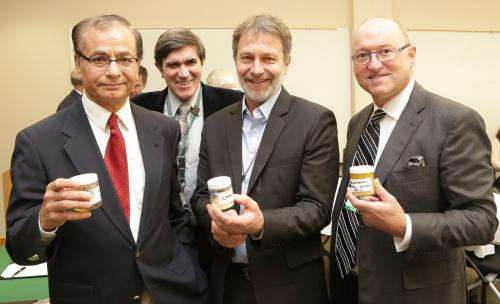Vertimass LLC, a California-based start-up company, has licensed an Oak Ridge National Laboratory technology that directly converts ethanol into a hydrocarbon blend-stock for use in transportation fuels. ORNL inventors (from left) Chaitanya Narula, Brian Davison and Martin Keller display the technology with Vertimass chairman William Shopoff. Credit: Oak Ridge National Laboratory
Vertimass LLC, a California-based start-up company, has licensed an Oak Ridge National Laboratory technology that directly converts ethanol into a hydrocarbon blend-stock for use in transportation fuels.
The ORNL technology offers a new pathway to biomass-derived renewable fuels that can lower greenhouse gas emissions and decrease U.S. reliance on foreign sources of oil.
"Vertimass is very pleased to be partnering with ORNL to commercialize this revolutionary technology that can broaden the market for alternative fuels, " said Vertimass chairman William Shopoff. "We have assembled a team of industry and technology leaders, including Dr. Charles Wyman, our president and CEO, who will take this novel catalyst from the lab to the marketplace. We see this technology as a significant step in moving the United States toward energy independence."
The technology developed by ORNL's Chaitanya Narula, Brian Davison and Associate Laboratory Director Martin Keller uses an inexpensive zeolite catalyst to transform ethanol into hydrocarbon blend-stock. The resulting liquid can be blended at various concentrations into gasoline, diesel and jet fuels without negatively affecting engine performance. After mixing with petroleum-derived fuels, the blend-stock does not require modifications to the existing distribution infrastructure.
"This technology is a pathway to overcome the ethanol blend-wall," Narula said. "The blend-stock can be mixed into gasoline at higher concentrations than ethanol's current limit of 10 percent; plus it can be added to diesel and jet fuel. It's completely consumer-transparent."
Vertimass anticipates that the ORNL technology will be in demand by existing corn-based ethanol production plants, as well as new refineries coming online that aim to convert non-food crops such as switchgrass, poplar wood and corn stover into biofuels. The technology could also supply a source of renewable jet fuel required by recent European Union aviation emission regulations.
"We plan to move quickly to make a bolt-on technology easily accessible to ethanol producers so they can expand their product line," Shopoff said. "It could also be incorporated into new plant designs to further reduce operating costs. We hope to move from the laboratory scale to a commercially available technology within four to six years."
Preliminary ORNL analysis in collaboration with the National Renewable Energy Laboratory in Colorado shows the catalytic technology could be retrofitted into existing bio-alcohol refineries at various stages of ethanol purification. The direct conversion process produces minimal amounts of ethylene by-product, making the technology more cost-effective than previous approaches. The ORNL team's lab-scale tests also indicate the catalyst can operate at relatively low temperatures and pressures and can be regenerated under mild conditions, helping the technology withstand long periods of operation without significant degradation.
Provided by Oak Ridge National Laboratory


















